PRINCETON, NJ -- The decoupling of consumer spending from consumer confidence couldn't be clearer. Gallup's Consumer Spending measure last week tumbled 17% from the prior week and 39% from a year ago, even as Gallup's Job Creation Index tied its best level of the year and Gallup's Consumer Confidence Index hit a new 21-month high.
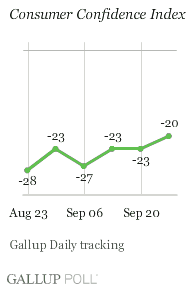
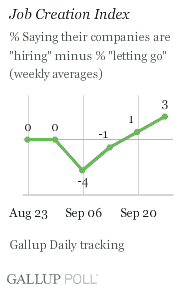

What Happened (Week Ending Sept. 27)
-
Consumer Spending took a tumble last week, as self-reported average daily spending in stores, restaurants, gas stations, and online fell by $12 -- offsetting the previous week's gain and resulting in a $60-per-day spending level. This is down 17% from the prior week and 39% from the same week a year ago. More importantly, it seems to be something of a "new normal" for consumers in 2009, with consumer spending remaining in a fairly tight $59- to $65-per-day average range each month since the beginning of the year.
-
Job Creation improved further last week, as Gallup's Job Creation Index increased to +3 -- its third weekly improvement in a row and matching its best level of 2009, previously seen the week of May 11-17. More importantly, the percentage of employees saying their companies are hiring (27%) was also at its highest level of the year. The percentage of workers saying their companies are letting people go was 24% -- essentially unchanged from the 23% of the prior week. The percentage of companies reported to be hiring is down 7 percentage points from the same week a year ago, while job losses are up 6 points.
-
Consumer Confidence is at a 21-month high: Gallup's Consumer Confidence Index is at -20. A year ago, the Index was at -60. The 43% of Americans saying the economy is "getting better" and the 52% saying it is "getting worse" are the best respective readings on this measure since Gallup Daily tracking began in January 2008. But even after this sharp improvement in optimism about the future direction of the economy, 43% of Americans rate the current economy as "poor," reflecting the fact that most have yet to see its improvement in their daily lives.
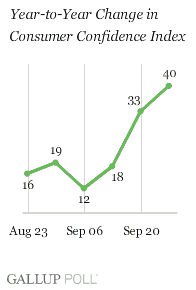

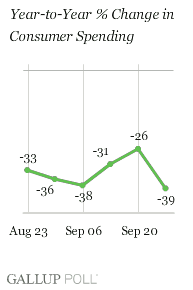
What to Watch For
On Tuesday morning, the Conference Board will report its Consumer Confidence Index. It should increase once again, as it did in August, given that Gallup's own Consumer Confidence Index has been improving throughout September. While most consumers believe the recession continues, most also think things will be better a year from now.
Of course, the big economic news this week is likely to be Friday's unemployment report. Leading up to it will be Thursday's jobless claims numbers. Gallup's Job Creation Index through last week continues to improve, suggesting a decline in jobless claims. However, the last few weeks' decline has been larger than anticipated, indicating that this Thursday's report is likely to show an increase over the 530,000 reported last week. Regardless of what the government reports, Gallup's Job Creation Index suggests that a much-needed, if modest, improvement in job-market conditions may be underway.
Still, Gallup's modeling also suggests that the unemployment rate is likely to go up again on Friday, to 9.8% or possibly even higher. While the deterioration in job-market conditions may be showing modest improvement, it is not enough to keep the number of unemployed Americans from continuing to grow -- particularly if some who have stopped looking for work begin doing so once again. As a result, Main Street is likely to feel as though the recession continues even as the government's economic statistics say it has ended.
While consumer confidence and jobs may get most of the attention during the week ahead, the most important thing to watch right now is likely to be consumer spending. Gallup's behaviorally based measure suggests there is a "new normal" for spending that is decoupled from consumer confidence. Although consumer confidence and the stock market have greatly improved since March, spending seems to be unaffected. This new normal level of consumer spending could be difficult for retailers and business in general this holiday season.
However, it is possible that a significant improvement in job-market conditions -- such as that seemingly taking place in the Midwest -- could boost spending in the future. This is more likely to occur if the recent uptick in job-market conditions turns out to be more of a trend, rather than just another positive blip like that of Mid-May.
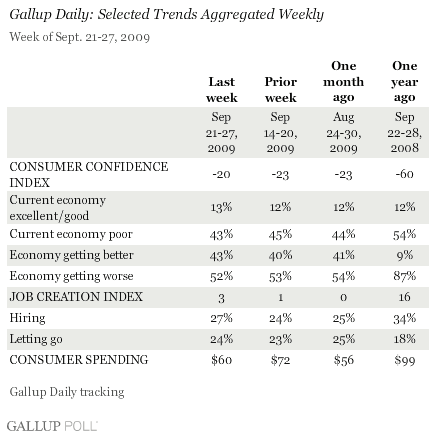
Review and export the complete daily trends on these measures: Economic Indexes; Consumer Spending; Economic Outlook; Economic Conditions; Job Market
Learn more about Gallup's economic measures.
Survey Methods
For Gallup Daily tracking, Gallup interviews approximately 1,000 national adults, aged 18 and older, each day. The Gallup consumer perceptions of the economy and consumer spending results are based on random half-samples of approximately 500 national adults, aged 18 and older, each day. The Gallup job creation and job loss results are based on a random half sample of approximately 250 current full- and part-time employees each day. Results from the week of Sept. 21-27, 2009, are based on telephone interviews with 3,400 adults for the consumer perceptions and spending questions. For these results, one can say with 95% confidence that the maximum margin of sampling error is ±2 percentage points. Results for the job creation and job loss questions are based on interviews with 1,905 employees, with a maximum margin of error of ±3 percentage points.
Interviews are conducted with respondents on land-line telephones (for respondents with a land-line telephone) and cellular phones (for respondents who are cell-phone only).
In addition to sampling error, question wording and practical difficulties in conducting surveys can introduce error or bias into the findings of public opinion polls.
